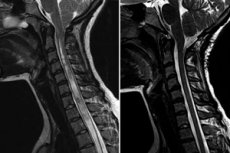Syringomyelia prognosis
Last reviewed: 19.10.2021

All iLive content is medically reviewed or fact checked to ensure as much factual accuracy as possible.
We have strict sourcing guidelines and only link to reputable media sites, academic research institutions and, whenever possible, medically peer reviewed studies. Note that the numbers in parentheses ([1], [2], etc.) are clickable links to these studies.
If you feel that any of our content is inaccurate, out-of-date, or otherwise questionable, please select it and press Ctrl + Enter.

Exemption from physical education with syringomyelia
Expressed physical activity is contraindicated in patients with syringomyelia. Hiking, skiing, light gymnastic exercises are allowed. Running, jumping, strength and static exercises are excluded.
It is important to remember that physical inactivity is just as harmful as strenuous physical activity. Therefore, sick people need to find a "golden mean" and remain active, without resorting to overloading the body and, in particular, the spine, abdominal and chest cavities.
Syringomyelia and disability
The frequency of registration of disability as a result of syringomyelia is about 3% among all disabled people with organic pathology of the nervous system. Disability is assigned to patients in 80% of cases (more often we are talking about the second group of disability, somewhat less often about the third group, and even less often about the first group).
Only specialists of medical and social expertise can recognize a patient with syringomyelia as disabled. Health status is assessed according to specific criteria, which become the basis for assigning a group. In some cases, disability may be denied.
The family doctor can refer the patient to the commission. To prove the existing health problem, the patient must provide written epicrisis, certificates and documents confirming the presence of pathological disorders in the body, as well as symptoms that do not allow a person to live and work normally. [ * ]
Syringomyelia and the army
Young people with proven degenerative pathologies of the central nervous system of hereditary or acquired origin, as well as neuromuscular diseases in which organic changes are present, are exempted from conscription. Such diseases usually develop in one of two ways:
- progressing slowly, showing insignificant faint clinical signs;
- do not show progress for several years of continuous medical supervision.
If a patient is diagnosed with syringomyelia, which is not manifested by dissociated sensory disorders, is not accompanied by trophic disorders, such as muscle atrophy, etc., then he may be recognized as fit for military service. In the presence of persistent clinical symptoms, and even more so, if the patient's condition worsens, he is released from the army.
When passing the draft board, a conscript suffering from syringomyelia must provide papers on fixed calls to a neurologist. If the disease is accompanied by disorders of consciousness, then this must be documented. Confirmatory documents are considered to be certificates from "emergency medical care", from the attending physician and other doctors, which indicate the patient's regular complaints about the disease. If such documentation is not available, the conscript may:
- take into the army;
- send for additional diagnostics.
Experts recommend thinking in advance about preparing for the call. This is facilitated by a timely appeal to doctors, the collection of all the necessary documents attached to the personal file of the conscript. Syringomyelia by itself, which is not accompanied by clinical symptoms, does not qualify for exemption from military service.

